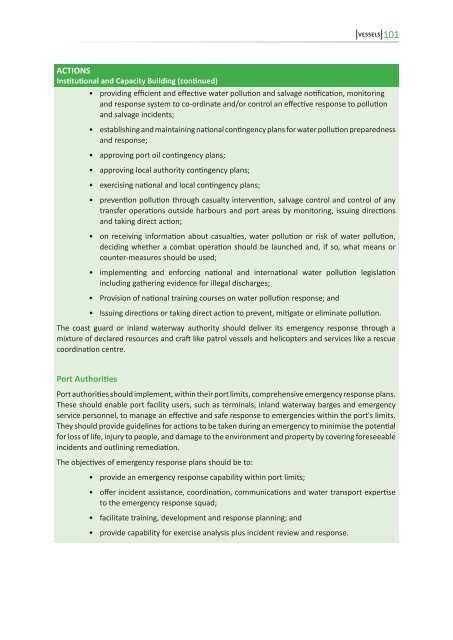Carriage, Handling and Storage of Dangerous Goods along
Carriage, Handling and Storage of Dangerous Goods along
Carriage, Handling and Storage of Dangerous Goods along
Create successful ePaper yourself
Turn your PDF publications into a flip-book with our unique Google optimized e-Paper software.
ACTIONS<br />
Institutional <strong>and</strong> Capacity Building (continued)<br />
VESSELS 101<br />
• providing efficient <strong>and</strong> effective water pollution <strong>and</strong> salvage notification, monitoring<br />
<strong>and</strong> response system to co-ordinate <strong>and</strong>/or control an effective response to pollution<br />
<strong>and</strong> salvage incidents;<br />
• establishing <strong>and</strong> maintaining national contingency plans for water pollution preparedness<br />
<strong>and</strong> response;<br />
• approving port oil contingency plans;<br />
• approving local authority contingency plans;<br />
• exercising national <strong>and</strong> local contingency plans;<br />
• prevention pollution through casualty intervention, salvage control <strong>and</strong> control <strong>of</strong> any<br />
transfer operations outside harbours <strong>and</strong> port areas by monitoring, issuing directions<br />
<strong>and</strong> taking direct action;<br />
• on receiving information about casualties, water pollution or risk <strong>of</strong> water pollution,<br />
deciding whether a combat operation should be launched <strong>and</strong>, if so, what means or<br />
counter-measures should be used;<br />
• implementing <strong>and</strong> enforcing national <strong>and</strong> international water pollution legislation<br />
including gathering evidence for illegal discharges;<br />
• Provision <strong>of</strong> national training courses on water pollution response; <strong>and</strong><br />
• Issuing directions or taking direct action to prevent, mitigate or eliminate pollution.<br />
The coast guard or inl<strong>and</strong> waterway authority should deliver its emergency response through a<br />
mixture <strong>of</strong> declared resources <strong>and</strong> craft like patrol vessels <strong>and</strong> helicopters <strong>and</strong> services like a rescue<br />
coordination centre.<br />
Port Authorities<br />
Port authorities should implement, within their port limits, comprehensive emergency response plans.<br />
These should enable port facility users, such as terminals, inl<strong>and</strong> waterway barges <strong>and</strong> emergency<br />
service personnel, to manage an effective <strong>and</strong> safe response to emergencies within the port's limits.<br />
They should provide guidelines for actions to be taken during an emergency to minimise the potential<br />
for loss <strong>of</strong> life, injury to people, <strong>and</strong> damage to the environment <strong>and</strong> property by covering foreseeable<br />
incidents <strong>and</strong> outlining remediation.<br />
The objectives <strong>of</strong> emergency response plans should be to:<br />
• provide an emergency response capability within port limits;<br />
• <strong>of</strong>fer incident assistance, coordination, communications <strong>and</strong> water transport expertise<br />
to the emergency response squad;<br />
• facilitate training, development <strong>and</strong> response planning; <strong>and</strong><br />
• provide capability for exercise analysis plus incident review <strong>and</strong> response.













